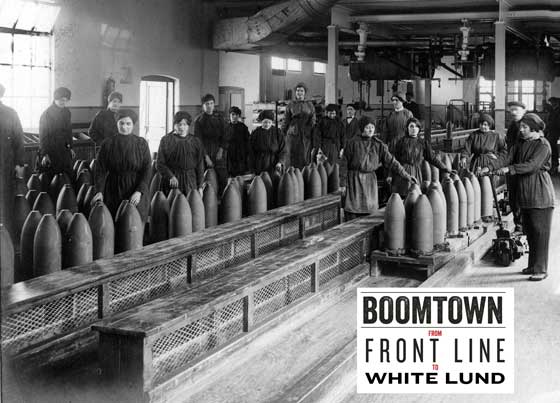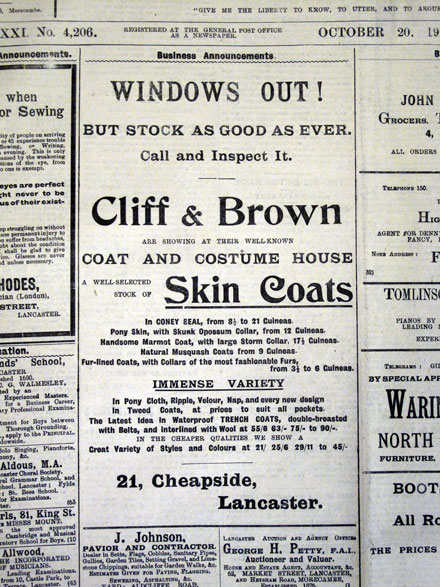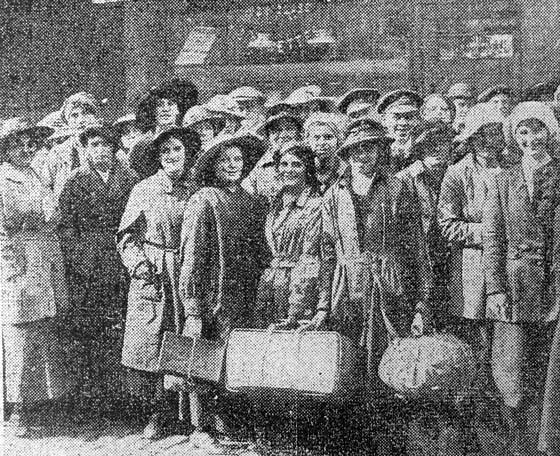The Great War Centenary
1917 - ExhibitionBoomtown - From
Front Line to White Lund
How Did People React?

Although the works were ‘officially’ a secret, local residents were
well aware of what was being produced at White Lund. When the explosions
started, around 10.30pm on 1st October, some people thought it was a
German Zeppelin airship bombing raid. Others, no doubt, guessed the real
source.
The Lancaster Observer’s report of the explosion was withheld by censors
until 24th January 1919:
‘A violent explosion, a crash, a rumbling echo around the neighbouring
fells, a shaking of everything on the surrounding earth, and
instinctively the great mass of humanity, whether asleep or awake, had
full knowledge.’
The Daily Post in Preston wrote its own report but was not able to
publish this until 25th January 1919. In this they stated that:
‘Thirty thousand people of Lancaster, Morecambe and surrounding villages
wandered through the night in all states of deshabilie, taking to the
hills or the open expanse of seashore, and there was not a country land,
church, chapel or barn for miles around where people were not seeking
shelter from what they deemed to be imminent danger.’
We cannot be sure of the numbers moving around in search of safety. We
do know that many made for Morecambe to shelter on the beach, protected
by the prom walls. Some munition workers, who were ‘on days’, were told
to get up and run to Heysham Harbour. Others made for the surrounding
countryside – Quernmore, Galgate, Hest Bank, Bolton-le-Sands, Hornby and
Caton.
There were many reports of windows blowing in with the many blasts. Some
windows remained broken for weeks afterwards.
In reports after the disaster the claim that Special (Police) Constables
were keeping folk away from their homes were investigated and denied by
the Police.
A handbill from the Borough of Morecambe shows that claims for reglazing
broken windows were to be dealt with by the Ministry of Munitions.
Perhaps a similar arrangement also existed in Lancaster.

An advert for Cliff & Brown, Cheapside, Lancaster, is headed "Windows
Out!" clearly indicating that their windows had suffered damage and
still had not been replaced by 20th October 1917.
Although many munitions workers were paid two weeks’ wages and
encouraged to leave for home or for other works, some must have stayed
in the area. The local paper, on 28th October, said:
‘During the past week a good many girls have availed themselves of the
rooms at St. Lawrence’s Schools opened last week by the Lady Mayoress of
Morecambe. Willing workers have been most assiduous in doing what they
could to make the whole surroundings happy and bright. The atmosphere
created is such that it will prove attractive.’
St Mary’s National School (Lancaster) records in its log book
that ‘Plate glass windows [are] smashed to atoms’ but, miraculously, on
2nd October ‘Only slight damage in school, 4 broken windows, + 3 falls
of plaster. No school all day. Terrible explosion hourly expected, town
deserted. Explosions at intervals all day and night.’
Skerton Council School’s log books show more damage:
‘Owing to the great disaster which took place at the Munition Works on
Monday Oct 1st, the school was closed on Tuesday – only two children
presented themselves. The attendance during the week gradually improved
but did not reach the normal state. About 60 panes of glass and two
clocks were damaged by the concussion.’ In the Infants some 23 window
frames were broken along with the large window fixtures and springs.
Sightseers & souvenir hunters
‘The Lancaster Observer mentions sightseers ‘engaged in the task of
picking up souvenirs’ soon after site was secured. The museum has a
number of pieces of shrapnel found and saved by local people. There may
be much more still in the hands of local families.
Nervous disposition
Audrey Pearson, nee Fleetwood, says her mother, Ada Fleetwood, was
pregnant with Audrey’s elder sister Winne when the White Lund explosion
took place. Ada went down on to the beach during the explosions. Winne
turned out to have rather a nervous disposition and her mother always
said it was because of that experience.
Local stories have emerged in newspaper reports and in interviews
held in the Elizabeth Roberts Archive:-
‘I always remember when the White Lund explosion blew up. Mother was
working at the Projectile Factory on nights and he [Archie] was supposed
to be looking after us because he was the eldest. There were three loud
bangs come at our door in the bedroom and I shouted “Give up Archie
don’t act so daft.” I thought it was him playing the fool and it was the
first three explosions of White Lund and we landed at [walked to] Caton
Institute. Mother had to come looking for us the day after.’

Within a day or so of the explosion many workers had left Morecambe as
reported, with the above photograph, by the Daily Despatch on 4th October 1917.
© Images are copyright, Trustees of the King's Own Royal Regiment Museum.
You must seek permission prior to
publication of any of our images.
Only a proportion of our collections
are on display at anyone time. Certain items are on loan for display
in other institutions. An appointment is required to consult any of
our collections which are held in store.




